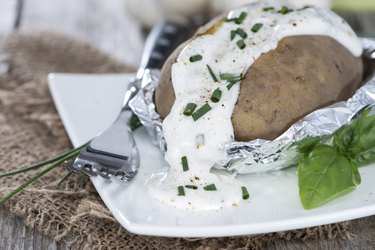
Have you ever cooked a baked potato in the convection oven? Rich in fiber and complex carbs, this meal is ideal for those days when you need more energy. Enjoy it before and after your workouts or serve it with fish, poultry or lean meat for a hefty protein punch.
Tip
There's a lot of debate on whether aluminum foil should be used when baking potatoes in a convection oven. For a crispy texture, cook the potatoes at 400 degrees Fahrenheit and wrap them in aluminum after, not during, baking.
Video of the Day
The Surprising Benefits of Potatoes
White potatoes have a bad reputation because of their high carb content. Yet they're a powerhouse of nutrition. A single serving (about 5.2 ounces) offers more than 17 percent of the daily recommended potassium intake and 16 percent of the daily recommended allowance of vitamin C. Here's a quick breakdown of the calories and nutrients in one serving of baked potatoes (with skin):
Video of the Day
- 138 calories
- 3.7 grams of protein
- 31.3 grams of carbs
- 3.3 grams of fiber
- 0.2 grams of fat
- 9 percent of the DV (daily value) of iron
- 10 percent of the DV of magnesium
- 17 percent of the DV of potassium
- 19 percent of the DV of copper
- 2 percent of the DV of calcium
- 5 percent of the DV of zinc
- 16 percent of the DV of vitamin C
- 27 percent of the DV of vitamin B6
Vitamin B6, one of the most abundant nutrients in white potatoes, contributes to over 100 enzyme reactions, especially those involved in protein metabolism. It also supports cognitive development and immune function, according to the National Institutes of Health.
A review published in Advances in Nutrition in May 2013 points out that white potatoes have their place in a balanced diet. What matters most is how you cook them.
Bake Potatoes in Aluminum Foil
Cooking a baked potato in the convection oven is a quick, easy way to boost your potassium and fiber intake. Your body needs potassium to maintain its fluid balance, while fiber keeps you regular and promotes colon health, states the Mayo Clinic.
Start with a simple yet delicious recipe, such as potatoes baked in aluminum foil. Preheat the convection oven at 350 degrees Fahrenheit, as recommended by the Ira A. Fulton College of Engineering. Wash the potatoes thoroughly, scrubbing them with a firm brush. Next, pierce them with a fork or knife in several places to prevent them from bursting open in the oven, advises Southern Living.
Rub their skin with cooking oil for extra crispiness. Wrap them in aluminum foil, with the shiny side in. According to the Ira A. Fulton College of Engineering, this trick will result in shorter cooking times. As it turns out, the shiny side of the foil absorbs more radiation from the oven than the dull side, leading to faster cooking.
Southern Living, on the other hand, doesn't recommend using aluminum foil because it traps the steam released by potatoes during baking, which may affect their crispness and increase moisture. The Idaho Potato Commission advises against wrapping the potatoes in aluminum foil, too. However, the commission states that you can do it after baking to keep them warm (at about 180 degrees Fahrenheit) for up to 45 minutes.
At the end of the day, it's up to you to decide whether it's worth using aluminum foil. You may save time in the kitchen, but the result might not be as great as you expect.
Cooking Time and Temperature
If you do a browser search for "convection bake potatoes time" or "cooking temperature for baked potatoes," you might end up feeling confused. Most recommendations are conflicting at the least.
The Idaho Potato Commission recommends baking potatoes in the convection oven at 375 degrees Fahrenheit. However, cooking them at 400 degrees yields better results. Their internal temperature should be around 210 degrees when fully cooked. Bake your potatoes until they reach this temperature, or until you can easily pierce them with a fork.
Cooking time will range between 40 and 50 minutes, depending on whether you wrap them in aluminum foil, what other ingredients you use and the performance of your oven. According to Fine Cooking, baking potatoes or other foods in the convection oven takes about 25 percent less time compared to a traditional oven. For best results, use a baking pan with low sides.
This isn't the only way to bake potatoes, though. You may also try convection oven potato wedges, baked sweet potatoes with chopped almonds, cheesy stuffed baked potatoes and other delicious, healthy dishes.
If you're planning to use a recipe designed for traditional ovens, subtract 25 to 30 degrees Fahrenheit from the temperature listed, recommends Gourmet Sleuth. Another option is to bake at conventional oven temperature but cut the cooking time by 25 to 30 percent. To stay on the safe side, check the user guide and manufacturer's instructions that came with your convection oven.
- USDA: "Nutrition Facts for Baked Potatoes"
- NIH: "Vitamin B6"
- Advances in Nutrition: "White Potatoes, Human Health, and Dietary Guidance"
- NIH: "Potassium"
- Mayo Clinic: "Dietary Fiber: Essential for a Healthy Diet"
- Ira A. Fulton College of Engineering: "Hot Potato!"
- Southern Living: "Do You Really Need to Poke Holes in a Baked Potato?"
- Idaho Potato Commission: "Foil Baked Potatoes"
- Idaho Potato Commission: "How Do I Cook a Large Quantity of Baked Potatoes in a Commercial Convection Oven?"
- Fine Cooking: "Better Cooking Through a Convection Oven"
- Gourmet Sleuth: "Recipe Adjustments for Convection Ovens"